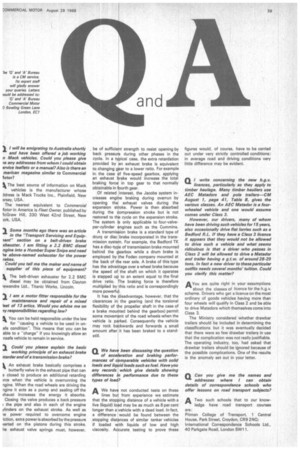I Could you please explain the basic working principle of an exhaust brake ?tarder and of a transmission brake?
Page 61

If you've noticed an error in this article please click here to report it so we can fix it.
kAn exhaust brake basically comprises a
butterfly valve in the exhaust pipe that can closed to produce an additional retarding irce when the vehicle is overrunning the ngine. When the road wheels are driving the ngine it acts as a pump and sealing off the Khaust increases the energy it absorbs.
Closing the valve produces a back pressure
the pipe and also in each of the engine ylinders on the exhaust stroke. As well as le power required to overcome engine iction, extra power is absorbed by the pressure Kerted on the pistons during this stroke. he exhaust valve springs must, however,
be of sufficient strength to resist opening by back pressure during other phases in the cycle, in a typical case, the extra retardation provided by an exhaust brake is equivalent to changing gear to a lower ratio. For example in the case f five-speed gearbox, applying an exhaust rake would increase the total braking fort in top gear to that normally obtainable in ourth gear.
Of related interest, the Jacobs system increases erigi e braking during overrun by opening the exhaust valves during the expansion et oke. Power is then absorbed during the ompression stroke but is not restored to the cycle on the expansion stroke. The system is only applicable to four-valveper-cylinder engines such as the Cummins.
A transmission brake is a standard type of drum or disc brake incorporated in the transmission system. For example, the Bedford TK has a disc-type of transmission brake mounted behind the gearbox while a drum brake is employed by the Foden company mounted at the back of t has the adva the speed of is stepped u drive ratio. multiplied by more powerf It has the e rear axle. A brake of this type tage over a wheel brake because the shaft on which it operates to an extent equal to the final he braking force is therefore this ratio and is correspondingly
isadvantage. however, that the clearances in the gearing (and the torsional flexibility of tile propeller shaft in the case of a brake mounted behind the gearbox) permit some movement of the road wheels when the vehicle is parked. Consequently the vehicle may rock backwards and forwards a small amount after it has been braked to a standstill.
It has the




































































































